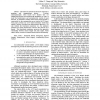Free Online Productivity Tools
i2Speak
i2Symbol
i2OCR
iTex2Img
iWeb2Print
iWeb2Shot
i2Type
iPdf2Split
iPdf2Merge
i2Bopomofo
i2Arabic
i2Style
i2Image
i2PDF
iLatex2Rtf
Sci2ools
ICRA
2006
IEEE
2006
IEEE
A Kinematic Thumb Model for the ACT Hand
- The thumb is essential to the hand’s function in grasping and manipulating objects. Previous anthropomorphic robot hands have thumbs that are biologically-inspired but kinematically-simplified. In order to study the biomechanics and neuromuscular control of hand function, an anatomical robotic model of the human thumb is constructed for the anatomically-correct testbed (ACT) hand. This paper presents our ACT thumb kinematic model that unifies a number of studies from biomechanical literature. We also validate the functional consistency (i.e. the nonlinear moment arm values) between the cadaveric data and the ACT thumb. This functional consistency preserves the geometric relationship between muscle length and joint angles, which allows robotic actuators to imitate human muscle functionality.
ACT Thumb | ICRA 2006 | Robotics | Thumb | Thumb Kinematic Model |
| Added | 11 Jun 2010 |
| Updated | 11 Jun 2010 |
| Type | Conference |
| Year | 2006 |
| Where | ICRA |
| Authors | Lillian Y. Chang, Yoky Matsuoka |
Comments (0)

